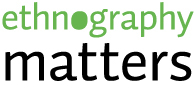The Person in the (Big) Data

This edition of is jam-packed with methods for doing people-centred digital research and is edited by Heather Ford, newly-appointed Fellow in Digital Methods at the University of Leeds and thus super excited to understand her role as an ethnographer who (also) does digital methods.
Today we launch the next edition of Ethnography Matters entitled: ‘Methods for uncovering the Person in the (Big) Data’. The aim of the edition is to document some of the innovative methods that are being used to explore online communities, cultures and politics in ways that connect people to the data created about/by them. By ‘method’, we mean both the things that researchers do (interviews, memo-ing, member checking, participant observation) as well as the principles that underpin what many of us do (serving communities, enabling people-centred research, advocating for change). In this introductory post, I outline the current debate around the risks of data-centric research methods and introduce two principles of people-centric research methods that are common to the methods that we’ll be showcasing in the coming weeks.
As researchers involved in studying life in an environment suffused by data, we are all (to at least some extent) asking and answering questions about how we employ digital methods in our research practice. The increasing reliance on natively digital methods is part of what David Berry calls the “computational turn” in the social sciences, and what industry researchers recognize as moves towards Big Data and the rise of Data Science.

‘Digital Methods‘ by Richard Rogers (2013)
First, a word on digital methods. In his groundbreaking work on digital methods, Richard Rogers argued for a move towards natively digital methods. In doing so, Rogers distinguishes between methods that have been digitized (e.g. online surveys) vs. those that are “born digital” (e.g. recommender systems), arguing that the Internet should not only be seen as an object for studying online communities but as a source for studying modern life that is now suffused by data. “Digital methods,” writes Rogers, “strives to follow the evolving methods of the medium” by the researcher becoming a “native” speaker of online vocabulary and practices.
The risks of going natively digital
There are, however, risks associated with going native. As ethnographers, we recognize the important critical role that we play of bridging different communities and maintaining reflexivity about our research practice at all times and this makes ethnographers great partners in data studies. Going native in this context, in other words, is an appropriate metaphor for both the benefits and risks of digital methods because the risk is not in using digital methods but in focusing too much on data traces.
Having surveyed some of debates about data-centric methodology, I’ve categorized the risks according to three core themes: 1. accuracy and completeness, 2. access and control, 3. ethical issues. Read More…



 For four years, Bradley Garrett (
For four years, Bradley Garrett (
 his month’s theme is about what it means to be a student ethnographer and is edited by Ethnomatters co-founder, Heather Ford (
his month’s theme is about what it means to be a student ethnographer and is edited by Ethnomatters co-founder, Heather Ford (
 Editors’ note: In our installment of August’s
Editors’ note: In our installment of August’s 














Recent Comments